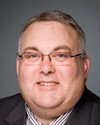Mr. Chair, I appreciate the opportunity to be here today to discuss the issues related to our ridings. My presentation will be brief, but it will complement what Mr. Duncan is saying.
Vancouver Island has the population to manage seven ridings. We have three-quarters of a million people on Vancouver Island. The way I've explained it to people is that with six ridings, we have an elevation at the south end called the Malahat which divides the capital region, which has three ridings, from the rest of Vancouver Island. So you have three ridings in a concurrent pattern below that area in the capital region where half the population of the island has traditionally been, and then you have the three in the northern part of the island. When we were receiving the extra riding, it pretty well had to straddle the Malahat somehow, which is what the current configuration does.
What really complicates things for Vancouver Island is the inclusion of Powell River, as my colleague John Duncan has just pointed out, because in addition to pushing north, displacing the existing representation and what's been in place for quite a while, is the poll to the north.... Basically, my riding just south of Vancouver Island North and Nanaimo—Alberni would be reconfigured. It would take me right out of Nanaimo, or the riding that I represent would no longer include Nanaimo or Lantzville. That would displace about 50,000 voters between the 45,000 that I currently represent in Nanaimo, the larger half, and the Lantzville region, so about 50,000 people at that end, and would add about 25,000 at the north end of the riding. About 75,000 people would have a significant change in their representation or their typical alignment.
I would agree with my colleague that separating Courtenay and Comox which are really twin cities is an unnatural thing to do. The mid-island area, Nanaimo, is the second largest city on the island. It is the hub city. It's also been rebranded as the harbour city, but for years it was known as the hub city, a transportation centre with 86,000 people.
For most of the area north all the way to Deep Bay, which is about 30 kilometres south of Courtenay boundary, all that regional governance is already in the Regional District of Nanaimo on the east side of the island, and therefore the flow of governance to Deep Bay—area H it's called—all the way down is to Nanaimo. The business flow is toward Nanaimo, with the exception of the northern communities.
My recommendation for Nanaimo—Alberni would follow that of John Duncan, which would leave the city of Courtenay intact as part of Courtenay—Comox, and it would roughly follow the southern boundary of the city of Courtenay. Outside the city boundaries would be part of Nanaimo—Alberni. This proposal requires that the solution for Powell River be found on the Lower Mainland. That would allow us to retain a smaller portion of Nanaimo, but at least you would be able to justify calling it Nanaimo—Alberni.
I have a proposal on the map before you that would take the first east-west major thoroughfare off the Nanaimo Parkway, which is the exit called Aulds Road. It becomes Hammond Bay Road, and if you look at the map I have provided, it follows that to a natural pinch point where Pipers Lagoon and the road are very close together. It's a natural choke point for population. There's a high elevation, so you could separate that piece of population.
I've included up to Mostar Road, which is the second road. It cuts across to Hammond Bay Road, and according to my calculation, you'd come out with a population of about 110,000. It would shrink the neighbouring riding of Nanaimo—Ladysmith, from about 114,000 to 105,000 to the target level, but it would be a shift that brings them both within the targets of the commission.
I would argue, frankly, that Nanaimo has had one MP's office primarily for the last 12 years in the north part of the city, inasmuch as the other one—and prior to my representing the area, there was no MP's office in a city with 80,000 people, because one was up in Qualicum Beach and the other was down in Duncan. People are used to coming to north Nanaimo for their services.
The current configuration would displace 75,000 people, as I have indicated there.
The advantages, the net effect would be...I mentioned the population numbers of about 110,000 for Nanaimo—Alberni. In Nanaimo—Ladysmith, we'd have about 105,000. We'd respect the wishes of Courtenay and Comox to remain together, creating a defined boundary outside the city of Courtenay. It would maintain the natural flow of business and government for most of the residents on the east side of Nanaimo—Alberni, which is towards Nanaimo.
I'll be glad to take any questions.






